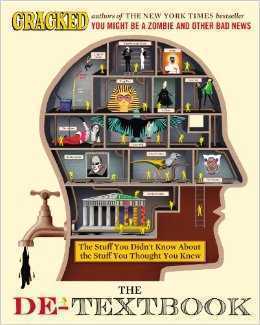6 Ridiculous Science Myths You Learned in Kindergarten

Right around the time we learn to start questioning the ways of this wonderful world around us, our parents start packing us onto school buses every morning, because who the hell has time for all those obnoxious questions? Let the professionals address the budding curiosity of our children; we've got America's Next Top Model to watch. Teachers are better equipped to deal with those questions anyway, right? Right!
Mostly. Teachers are people, too, and people have this nasty tendency to occasionally lob whatever untruth comes flying at them right back at somebody else like a game of bullshit ping pong. For example ...
Don't Miss
(We've got a lot more school-issued B.S. where that came from. Buy Cracked's De-Textbook and learn why everything you know about the founding of America is a lie.)
The Coriolis Effect Controls the Direction in Which Toilet Water Drains

The Myth:
As soon as we learn that the Earth rotates on its axis, we learn all the cool effects that this has on our lives. It gives us day and night, causes the stars to move across the sky, and causes the swirly to be a completely different hairstyle in Australia than in America. That last one is because of something called the Coriolis effect, which causes toilet water to drain in a counterclockwise direction in the Northern Hemisphere but in a clockwise direction in the Southern one.

On the equator, toilets don't flush at all. People bury their waste in the yard.
It makes sense: To the people facing down from the North, the Earth moves in a counterclockwise direction, while to the people facing up from the South, the Earth is rotating clockwise, thus causing the water in their respective hemispheres to drain in the direction of their perceived rotation.
The Reality:
The Coriolis effect is totally a thing, and it really does affect the direction in which things spin. Like this:

Say, when you and your enemy exchange grenades on a merry-go-round.
But the sharper-eyed among you might have noticed that, in the diagram above, the object was relatively big in relation to the spinning disc. And that's the trick: In order for Coriolis force to have an effect on earthly phenomena, said phenomena have to be really big. So Coriolis force affects the direction in which hurricanes and cyclones spin, seeing as how those things are massive amalgamations of murderwind, but it doesn't affect your little toilet, no matter how murderish your personal wind may be.

Even Dubai's controversial "world's largest toilet" proves immune.
When it comes to the water in your puny porcelain poop throne, Coriolis force does precisely squat. Coriolis force controls freaking weather systems; the only things controlling the direction in which your poop water drains are the shape of the toilet and exactly how badly you just clogged that bastard.
Diamonds Come from Coal

The Myth:
Everyone knows that if you want a diamond, you have three options: A) go down to your local jewelry store and overpay for it, B) get a hunk of coal, bury it deep in your backyard, and dig up your shiny fresh (and free!) diamond a short 10,000 years later, or C) make a drunken bet with Superman. That's because the two key ingredients in the recipe for diamonds are coal and immense pressure.

Substitute corn for coal, and you get something even better.
The Reality:
Actually, although scientists can't tell you with absolute certainty what the exact source of modern diamonds are, they mostly agree on one thing: It almost certainly ain't coal.
You see, the basic building block of all diamonds is carbon, not coal. Yeah, yeah, we know coal contains buttloads of carbon, but here's the thing: Scientists have taken a close look and determined that the carbon currently found in the vast majority of diamonds is old. Like, predates-all-of-Earth's-land-plants old. And guess what the source of all of Earth's coal is? You guessed it, smart guy: plants. (Now, diamonds could theoretically be made from coal -- if a coal plant was hit by a massive asteroid or a coal transport ship sank in the ocean and got pulled between continental plates somehow -- just because it's a source of carbon, but it's extremely unlikely.)

And gold could come from hydrogen. But it usually doesn't.
So why are we so widely taught that diamonds are formed from coal? Possibly because the real explanation is simply too metal to be included in the curriculum. The most prominent method of formation for diamonds goes like this: They're initially formed deep in the Earth's mantle from carbon-rich rocks that suffered skull-pulverizing pressure over eons and are then delivered to the surface via motherfucking volcanic explosions. With a badass backstory like that, we're pretty sure they've been marketing diamonds to the wrong gender all these years. It's an easy mistake to fix. Think of any overwrought Ford truck commercial you've seen, swap in diamonds for that F-150, and boom: You doubled your market.
You know what says "thank you" really well, diamond industry? It starts with "d" and contains "mon," and it's not Djimon Hounsou.
Dogs Can't Sweat (or They Sweat Through Their Tongues)

The Myth:
Dogs pant because they can't sweat. Weird, right? For some insane reason, nature saw fit to give man's best friend precisely zero sweat glands throughout their bodies and instead doomed them to flop their fleshy food scooper at the world whenever they need to cool off. Alternatively, you may have heard that dogs do sweat, but only through their tongues ...

And they clean the sweat off using the Coriolis effect.
The Reality:
... which you might recognize as a stupid and roundabout way to say "drooling." It's true, of course, that dogs pant because it helps them cool down when they're hot -- but that doesn't mean their tongue is a giant sweat gland. Nope, all that liquid you disgustedly wipe from your ankle on a hot summer day is good ol' spit. If you see a dog with a damp nose, there's about an equal chance between that dampness being sweat and toilet water. Turns out sweat is most readily visible on a dog's sniffer or on its foot pads, because on most dogs, those are the only places not covered by fur.

Rick, on the other hand, gets damp all over.
But don't take our word for it ... ask science. Way back in 1835, after humanity had invented boredom but before we'd perfected basic fucking empathy, some crazy scientists decided to see if dogs sweat by shaving them, strapping them to a board, applying heat pads to their bodies, and injecting them with freaking adrenaline just for good measure. And it turns out that both the heat pads and the panic juice made the dogs sweat from all over their body. Interesting information, to be sure, and we hope it gives you solace in hell, 19th century scientists.
So if dogs are in fact peppered with sweat glands, why the myth that they're unable to sweat? Probably because they don't sweat for the same reason you do. Only the sweat glands on their noses and foot pads are to help them cool off -- the rest are mainly to help them maintain their savory doggy stench.

So those scientists just got a bunch of dog stink for their troubles. Ha!
And while we're on the subject of long-held zoological misconceptions ...
(Albert Einstein had affairs with at least TEN different women. Buy our De-Textbook for more stories of pimp-ass scientists.)
Bats Are Blind

The Myth:
The ubiquitous old saying "blind as a bat" is probably a bit of an exaggeration, but it at least has its basis in fact. After all, as both creatures of the night and everyone's favorite antihero, bats really don't have much of a need for the eyeballs that Mother Nature bestowed, preferring to instead rely on their sense of echolocation and justice, respectively.

Kind of like dolphins, except dolphins don't give a shit about justice.
The Reality:
Bats' eyeballs are more functional than decorative. According to Merlin Tuttle of Bat Conservation International, "There are no blind bats. They see extremely well." Yes, you read that right: Barring the occasional tragic affliction, there is no such thing as a blind bat.

Even the ones with cataracts just opt for surgery.
In fact, bats' retinas have not only an abundance of rods (a prerequisite for night vision), but also two types of cones: the run-of-the-mill variety that serves them well in daylight conditions, and a second, UV-sensitive type that gives them freaking Predator vision. Even the widespread assumption that bats depend exclusively on their sonar is flawed when you consider the fact that of the two types of bats -- fruit bats (the kind that feed on flowers and, um, fruit) and microbats (the kind that occupy a space in your nightmares completely disproportionate to their size) -- only one of them uses echolocation. When your prey is less the "fluttering through the darkness" variety and more the "hanging stationary from a branch" one, sonar just isn't all it's cracked up to be. No, for bats that feed on fruit or nectar, UV vision is the mutant superpower to have, considering that many flowers reflect ultraviolet light.
Hey, look at that! Science may have finally given us an explanation for Pink Batman.
Why Airplanes Fly

The Myth:
The explanation goes like this: The wings of a plane are designed in such a way that they make air travel faster over the top of the wing than under the bottom. This means the pressure over the wing is less than the pressure underneath, causing lift. It's called the Bernoulli principle, and even the pimp daddy of all nerds, Einstein himself, is said to have given it his thumbs up. Cased closed. Right?

The principle explains why something rises when you lean over it and blow.
The Reality:
Sorry to decompress your flight cabin there, Einstein, but the "differing pressures" explanation of flight isn't correct. Instead, what's really happening has a much simpler explanation -- one that you also learned in school. You see, according to a guy named Isaac Newton and his third law of motion, for every action there is an equal and opposite reaction. Therefore, if you want something to go up -- like, let's say, a plane -- then what you want to do is force air to go down and back so that the "opposite reaction" propels the object up and forward.
And that's where the shape of the wing comes in. It's true that a plane's wing must have a very specific shape -- just not the one that's postulated by the Bernoulli principle. Instead, the wing is angled so that it forces the air on top to go down toward its back end (downwash), creating upward force toward the front (upwash).

The effects of backwash, meanwhile, are exclusively taught in the school cafeteria.
The wing generates lift not by magically manipulating air pressure, but by using basic Newtonian physics. While the Bernoulli principle is a real thing, it has very little to do with the reason mankind can spit in God's eye from his hurtling metal tubes. And nobody is quite sure why your school's science textbooks, television, and, most alarmingly of all, goddamn pilot manuals have the wrong explanation for flight. But they don't need to know why the plane flies to fly it ... r-right?
Milk Is Good for Your Bones

The Myth:
Milk is good for your bones, because it has calcium (duh). Every kid learns this in kindergarten and is beaten over the head with it every day until they leave high school. After all, not only do we hear it in science class, but we're also given a dose of healthy milk with every single school lunch to wash down our daily allotment of Grade W hamburger (now with 50 percent less tendon!).

Sometimes we'd put ketchup in the milk and give it to Rick. Heh. Good ol' Rick.
The U.S. government apparently takes great pride in its totalitarian control of our cow juice intake, given that, according to The Man, children get so little calcium at home that, had someone not stepped in, every single American kid would grow up to be Samuel L. Jackson in Unbreakable.
The Reality:
It turns out that milk and its calcium-rich dairy cousins don't get you one bit closer to being the proud owner of a Wolverine-like skeleton.
To ascertain whether Big Calcium's claims were really correct, researchers at the Physicians Committee for Responsible Medicine analyzed the results of all the studies done on the subject and found that the vast majority of them found no evidence that drinking milk does what science teachers or be-hairnetted lunch ladies told you it would: "Neither increased consumption of dairy products, specifically, nor total dietary calcium consumption has shown even a modestly consistent benefit for child or young adult bone health." Moreover, a Cornell researcher found that the countries consuming the most cow's milk actually have the worst bone health in the world overall.

Of course that may be because those countries also have the most skateboarding.
While it's true that calcium gives bones their strength, it appears that drinking milk may not be the best way to get calcium, and that "exercise, heredity, hormone levels, smoking, protein intake, and intake of vitamins D and K matter more than milk."
Now, nobody's saying this is all a conspiracy by the government to force potentially lactose-intolerant children to drink fart-provoking milk in order to harness their precious methane to power the next wave of American war machines -- we just haven't heard anybody deny it, either. Don't you think that's strange?
You can contact Eddie with writing opportunities, or just to say hi, at firebugfilms@hotmail.com. Himanshu, meanwhile, is wondering what the hell's up with everybody over on Twitter.
We have some bad news: the food pyramid is a pile of lies, car gas tanks don't explode when shot, and your favorite book sellers are now selling a text book written and illustrated entirely by the Cracked team! Hitting shelves RIGHT NOW, Cracked's De-Textbook is a fully-illustrated, systematic deconstruction of all of the bullshit you learned in school.

It's loaded with facts about history, your body, and the world around you that your teachers didn't want you to know. And as a bonus? We've also included the kinkiest sex acts ever described in the Bible.